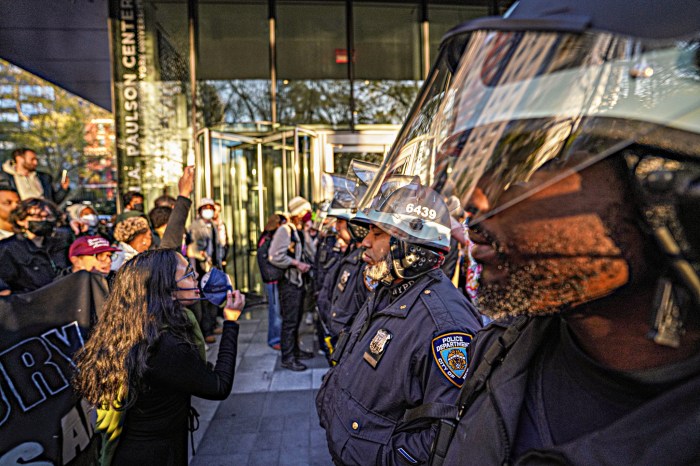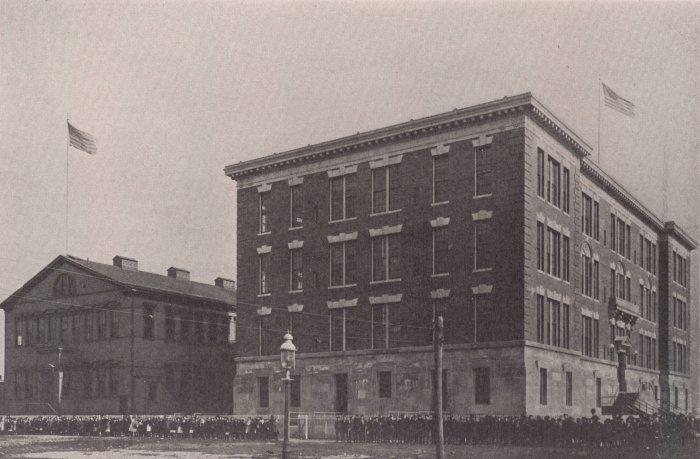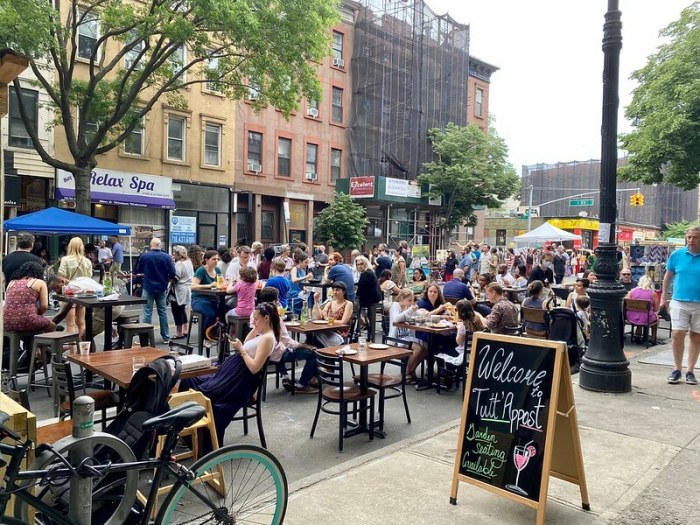
BY LINCOLN ANDERSON | After a 10-year community struggle to save St. Brigid’s Church from demolition, followed by a four-year-plus, $15 million renovation to shore up the historic structure and return it to its former splendor, the iconic Avenue B house of worship at last reopened on Sunday. The opening was celebrated with a joyful dedication Mass presided over by Archbishop Timothy Dolan.
To the chagrin of members of the Committee to Save St. Brigid’s, though, which fought and filed a lawsuit to keep the church standing, Dolan was joined in the celebration by former Archbishop Edward Egan. The latter had actually started demolishing St. Brigid’s before relenting in May 2008 and agreeing to accept a $20 million gift from an anonymous “angel” to fund the renovations, the parish and St. Brigid’s School.
It was controlled chaos before the 5 p.m. Mass, as people crowded the front doors near Eighth St. to get inside the church, which has a capacity of about 400.
Last year the parish of St. Emeric Church, at Avenue D and 13th St., was merged with St. Brigid’s parish, so the reopened church on Tompkins Square’s eastern edge is now being called St. Brigid and St. Emeric Church.
According to an archdiocese spokesperson, Governor Cuomo was invited to attend. He didn’t make it, though, but sent a representative. Seated in the front row were Councilmember Rosie Mendez and Congressmember Nydia Velazquez. The consulate generals of Ireland and Hungary also attended.
“May God the everlasting live in this place,” Dolan told the worshipers and celebrants packing the pews and the upstairs gallery.
“If this isn’t a day of gratitude, I don’t know what is,” he said.
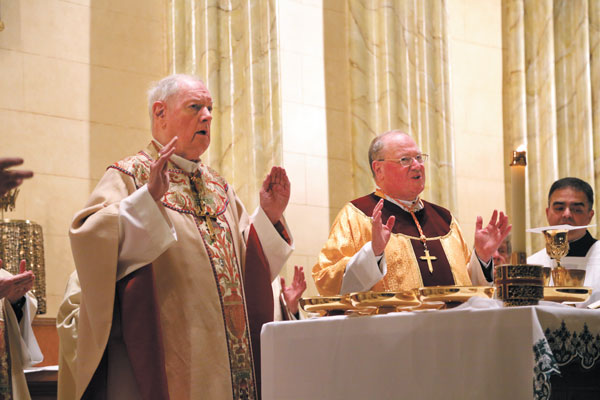
DOLAN PRAISES EGAN
He praised Egan, to his side, for saving the church, saying, “You made a rather daring decision” to resurrect St. Brigid’s in an era of belt-tightening by the archdiocese.
Dolan recalled the waves of immigrants who have worshiped at St. Brigid’s, starting with the Irish, who built it in 1848, Germans, Hungarians and Ukrainians, Italians and Hispanics.
Walking down the main aisle, the archbishop sprinkled congregants with water he had blessed, after which they quickly crossed themselves. Rolling up his shirtsleeves he then strode from the altar down the aisle to the church’s inner doorway, and grasping the door jam heartily, slathered holy water on it. Then he lit incense on the altar, which wafted in a great cloud up to the gallery on the church’s downtown side. Next, he lit candles on the altar.
“We’ve used everything,” Dolan said, “sight, hearing, fragrance.”
Tiny relics of St. Brigid and St. Emeric were also installed in an aperture in the altar.
In his remarks, Egan said, in part, “I want to congratulate the community of faith — St. Emeric and St. Brigid’s. You’re a blessing to Alphabet City, here in the East Village. … I want to thank the wonderful donor and the community.”
Members of the Committee to Save St. Brigid’s, however, were angry Egan was even up there speaking.
Yet Edwin Torres, the committee’s leader, did get to speak from the pulpit and give a reading of scripture.
ATO TO LEAD PARISH
Father Lorenzo Ato, the pastor of the new merged St. Brigid and St. Emeric, who was formerly just the pastor at St. Emeric, also recalled the many different ethnic groups who have called the Avenue B church home. He’s been given a big responsibility to carry on the tradition, he said.
“Now, we are living in a new era,” he said, “where St. Emeric and St. Brigid are united.”
Among those sitting in the upper gallery during the Mass were Andrea Calamaras and Lois Rotella, who both graduated from St. Brigid School’s eighth grade together in 1965.
“We had green uniforms and little green bowties, and a Peter Pan shirt collar,” recalled Calamaras, who now lives on Long Island. “Tuition was $3 a week. The things that go on today,” she added, “Monsignor Lynch wouldn’t have stood for it.”
Seated in the row behind her was a newcomer to the East Village, Ryan T., 28, who works in sales. For the past two years he has lived a couple of blocks away from the church, and now plans to attend services there.
“I used to go to Old St. Patrick’s [on Mulberry St.],” he said. “That was a 15-to-20-minute walk. This is two minutes.”
CRITIQUES AND CONDEMNATION
At a reception in the church’s lower hall after the dedication, Dolan posed for photos with parishioners and community residents as a mariachi band played.
Speaking at the reception, Roland Legiardi-Laura, who lives across from the church, and has keenly monitored its renovation, said he’s disappointed the steeples weren’t restored atop the church’s two towers. He said steel beams could be installed inside the towers’ corners to bear the steeples’ weight.
“The key word is that it’s difficult,” he said. “It’s not impossible.”
Meanwhile, Committee to Save St. Brigid’s members were fuming. One of them, Patricia Melvin said, “The committee is angry about the lies and the omissions [during the dedication Mass]. They didn’t once praise the Committee to Save St. Brigid’s. And they praised Egan.”
“Egan didn’t do anything,” said local stained-glass artist Patti Kelly. “He actually wanted to bring down the church.”
Torres, however, took the high road.
“I’m ecstatic,” he said. “I don’t need any recognition. The only one I care about is the Lord. The Lord up there knows what we did.”
“The rest of us are pissed,” chimed in committee member Courtney Weber. “Edwin and Dolly [Migdalia, Torres’s wife] should have been honored.”
Raised Catholic, Weber is a Wiccan who honors St. Brigid, who is also considered a pagan Celtic goddess by Wiccans.
DAUNTING RENOVATION JOB
At a press preview last Thursday, the architect and contractor who oversaw the church’s reconstruction called it a daunting challenge. St. Brigid’s eastern wall had separated from the building, putting the church at risk of collapse.
Michael Doyle of Acheson Doyle Architects said they were intent on preserving the reredos — the large, ornate, arch-like structures on the wall behind the altar — and really couldn’t have done this without preserving and keeping the wall standing during the renovation.
St. Brigid’s was designed by Patrick Keely and built by Irish boatwrights who worked in nearby shipyards on the East River.
“We never found any organized plans,” Doyle noted. “Everything was built from scratch, so to speak.”
Lead contractor Michael J. Fitzgerald said he’s worked on numerous church projects for the archdiocese, but this was the most challenging — and, from the sound of it, the most satisfying.
The two noted that the ground under the church — as in most of the East Village — is all swamp.
“We found a river under the north tower,” Fitzgerald added.
Fitzgerald said St. Brigid’s was built very well for its day in 1848, but that the subsoil conditions simply caused the church’s serious problems.
BUILDING A BETTER FOUNDATION
The building was constructed on top of wooden piles extending 26 feet down into the ground. Where the piles were submerged in the water, they were fine. It was in the area of the fluctuation of the water level — the top 6 feet of the piles — that they had become rotten, which was the reason the church was literally sinking, most obviously at its detached back wall. The solution was to cut out the tops of the wood piles and replace these sections with steel, then cement them together. On top of the fortified piles, a new, 20-inch slab of concrete was installed for the church’s lower-level floor, but not before lowering the floor by about a foot and a half to provide more headroom.
WINDOW WORK
As for the church’s windows, Fitzgerald said these were restored fairly faithfully. He said they found the remainder of the church’s windows that had been removed, and patterned the new stained glass after them. However, the angels that are featured in the middle of the windows ringing the church’s first floor were taken from Harlem’s Thomas the Apostle Church, which had been razed. St. Brigid’s original first-floor windows had featured saints and the names of Ireland’s counties.
The small, circular medallions in the church’s western windows, facing Avenue B, are original, however, as are the “thistles,” the four, small, triangular-shaped windows high on the church’s eastern wall.
St. Brigid’s original windows — some of which were sadly knocked out during the aborted demolition — weren’t stained glass but cheaper, painted glass, from Bavaria.
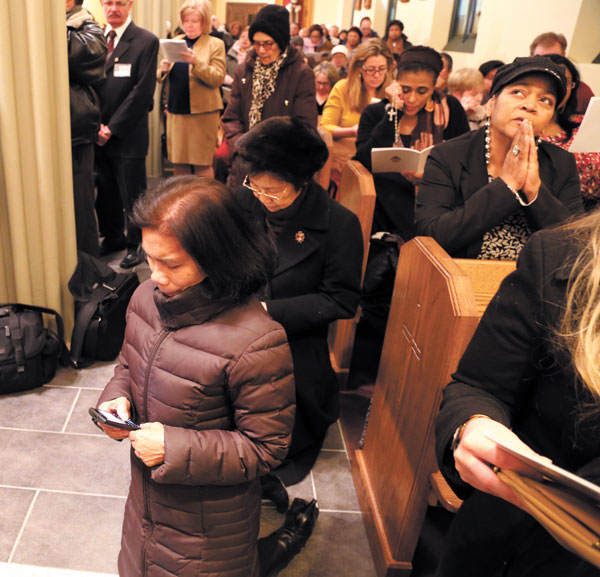
SOME FACES FROM THE PAST
Atop the church’s support columns in the upper-level gallery are plaster faces said to represent the original boatwrights who constructed the historic house of worship. Fitzgerald said these were recovered from Staten Island, where they were being stored. They’re painted gray so as to resemble stone.
In general, the church’s interior color schemes are based on layers of paint that they found while doing the renovation. At one point early in its history, the church’s walls had actually been “gaudy,” festooned with stencils, Fitzgerald said.
“There were more stencils than there was paint,” he said.
However, in the 1960s, during Vatican II, the church’s interior was dramatically altered, covered with carpeting and basically whitewashed, Doyle said.
As for the exterior, it was brownstone that didn’t age well. In the 1960s it was stuccoed and painted yellow. In the renovation, the church’s exterior walls were redone with precast concrete. The slate roof was redone with more durable — and some would say, more beautiful — copper cladding.
A CHALLENGE TOO STEEPLE
Regarding restoring the church’s steeples, which were removed for safety reasons in the 1960s, Fitzgerald said he knows the community really wanted this, but the way the church towers’ walls were constructed, they just can’t bear the weight. The slabs of the brownstone exterior undulated in thickness and were then backed by layers of bricks of varying thickness, so the walls don’t have the same load-bearing capacity as a more uniform wall, he said.
In a final touch, the massive original bell from 1858 was recently placed outside in front of the church.
For Doyle, the church was a special project, since he grew up nearby on E. 14th St. It was during a visit to St. Brigid’s as a child that he realized he wanted to be an architect.
Father Ato noted that a number of things had been brought over from St. Emeric, ranging from the sound system (“very expensive,” he noted) to the wooden Stations of the Cross that are interspersed with the first-floor windows, as well as various statuettes of saints, plus a three-year-old organ.
“The people are happy,” he said. “The parishioners are happy. Everything is new. We have air conditioning, we have nice heat.”
There will be two Masses in Spanish and five in English during the week, he said, in addition to 6 p.m. Saturday Mass in English and Sunday morning Masses in both languages.
“Maybe we have so many Chinese, we will add Chinese. We have to see,” he added.
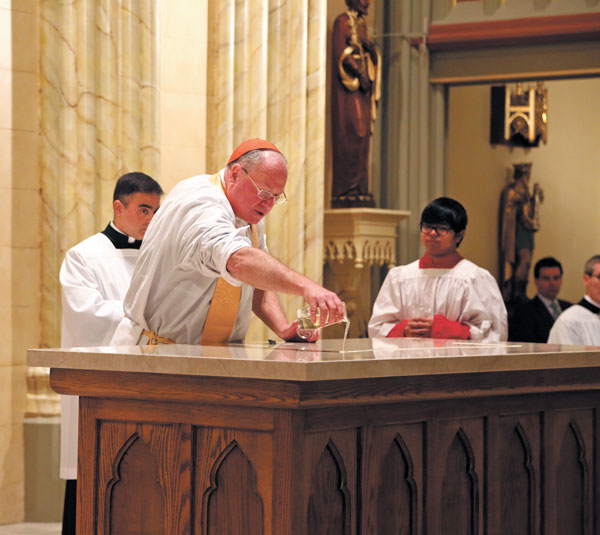
‘A WIN FOR THE COMMUNITY’
Councilmember Mendez, speaking at the reception after the dedication, said she understood the committee’s feelings. However, she said, “At the end of the day, it’s the joyous occasion. It’s the struggle — this wasn’t easy, it wasn’t something that the archdiocese wanted to do. We’re grateful that the angel came forward.”
Mendez noted that Democratic State Committeeman Michael Farrin has told her how the church, during the Tompkins Square Park riots, was a place to get medical help for activists and protesters injured by the police.
“In this community, where we have fought and lost so much — and we have won a few things — this gives us hope,” Mendez said of the beautifully restored church. “This wasn’t just fought by the committee and St. Brigid’s Church, it was fought by a lot of people in this community, different backgrounds, different faiths — people who love this community, and love this building.”











